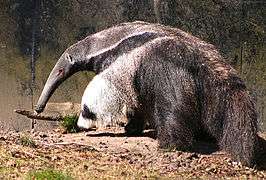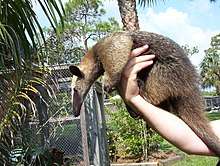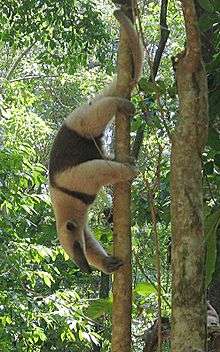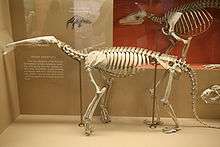Anteater
Anteater is a common name for the four extant mammal species of the suborder Vermilingua[1] (meaning "worm tongue") commonly known for eating ants and termites.[2] The individual species have other names in English and other languages. Together with the sloths, they are within the order Pilosa. The name "anteater" is also colloquially applied to the unrelated aardvark, numbat, echidnas, pangolins and some members of the Oecobiidae.
| Anteater | |
|---|---|
 | |
| Giant anteater | |
| Scientific classification | |
| Kingdom: | Animalia |
| Phylum: | Chordata |
| Class: | Mammalia |
| Order: | Pilosa |
| Suborder: | Vermilingua Illiger, 1811 |
| Families | |
Extant species are the giant anteater Myrmecophaga tridactyla, about 1.8 m (5 ft 11 in) long including the tail; the silky anteater Cyclopes didactylus, about 35 cm (14 in) long; the southern tamandua or collared anteater Tamandua tetradactyla, about 1.2 m (3 ft 11 in) long; and the northern tamandua Tamandua mexicana of similar dimensions.
Taxonomy
Classification




The anteaters are more closely related to the sloths than they are to any other group of mammals. Their next closest relations are armadillos. There are four extant species in three genera:
- Giant anteater (Myrmecophaga tridactyla)
- Silky anteater (Cyclopes didactylus)
- Northern (Tamandua mexicana) and southern tamandua (Tamandua tetradactyla)
There are several extinct genera as well.
Order Pilosa
- Suborder Folivora (sloths)
- Suborder Vermilingua (anteaters)
- Family Cyclopedidae
- Genus Cyclopes
- Silky anteater (C. didactylus)
- Genus †Palaeomyrmidon (Rovereto 1914)[3]
- Genus Cyclopes
- Family Myrmecophagidae
- Genus Myrmecophaga
- Giant anteater (M. tridactyla)
- Genus †Neotamandua (Rovereto 1914)[4]
- Genus Tamandua
- Northern tamandua (T. mexicana)
- Southern tamandua (T. tetradactyla)
- Genus †Protamandua (Ameghino 1904)[5]
- Genus Myrmecophaga
- Incertae sedis
- Genus †Argyromanis (Ameghino, 1904)
- †Argyromanis patagonica
- Genus †Orthoarthrus (Ameghino, 1904)
- †Orthoarthrus mixtus
- Genus †Argyromanis (Ameghino, 1904)
- Family Cyclopedidae
Evolution
Anteaters are one of three surviving families of a once diverse group of mammals that occupied South America while it was geographically isolated from an invasion of animals from North America, the other two being the sloths and the armadillos.
At one time, anteaters were assumed to be related to aardvarks and pangolins because of their physical similarities to those animals, but these similarities have since been determined to be not a sign of a common ancestor, but of convergent evolution. All have evolved powerful digging forearms, long tongues, and toothless, tube-like snouts to subsist by raiding termite mounds. This similarity is the reason aardvarks are also commonly called "anteaters"; the pangolin has been called the "scaly anteater"; and the word "antbear" is a common term for both the aardvark and the giant anteater.
Physical characteristics

All anteaters have elongated snouts equipped with a thin tongue that can be extended to a length greater than the length of the head; their tube-shaped mouths have lips but no teeth. They use their large, curved foreclaws to tear open ant and termite mounds and for defense, while their dense and long fur protects them from attacks from the insects. All species except the giant anteater have a long prehensile tail.[6]
Behaviour
Anteaters are mostly solitary mammals prepared to defend their 1.0- to 1.5-mi2 (2.6- to 3.9-km2) territories. They do not normally enter a territory of another anteater of the same sex, but males often enter the territory of associated females. When a territorial dispute occurs, they vocalize, swat, and can sometimes sit on or even ride the back of their opponents.[6]
Anteaters have poor sight but an excellent sense of smell, and most species depend on the latter for foraging, feeding, and defence. Their hearing is thought to be good.[6]
With a body temperature fluctuating between 33 and 36 °C (91 and 97 °F), anteaters, like other xenarthrans, have among the lowest body temperatures of any mammal,[7] and can tolerate greater fluctuations in body temperature than most mammals. Its daily energy intake from food is only slightly greater than its energy need for daily activities, and anteaters probably coordinate their body temperatures so they keep cool during periods of rest, and heat up during foraging.[6]
Reproduction
Adult males are slightly larger and more muscular than females, and have wider heads and necks. Visual sex determination can, however, be difficult, since the penis and testes are located internally between the rectum and urinary bladder in males and females have a single pair of mammae near the armpits. Fertilization occurs by contact transfer without intromission, similar to some lizards. Polygynous mating usually results in a single offspring; twins are possible but rare. The large foreclaws prevent mothers from grasping their newborns and they therefore have to carry the offspring until they are self-sufficient.[6]
Feeding
Anteaters are specialized to feed on small insects, with each anteater species having its own insect preferences: small species are specialized on arboreal insects living on small branches, while large species can penetrate the hard covering of the nests of terrestrial insects. To avoid the jaws, sting, and other defences of the invertebrates, anteaters have adopted the feeding strategy of licking up large numbers of ants and termites as quickly as possible — an anteater normally spends about a minute at a nest before moving on to another — and a giant anteater has to visit up to 200 nests per day to consume the thousands of insects it needs to satisfy its caloric requirements.[6]
The anteater's tongue is covered with thousands of tiny hooks called filiform papillae which are used to hold the insects together with large amounts of saliva. Swallowing and the movement of the tongue are aided by side-to-side movements of the jaws. The tongue is attached to the sternum and moves very quickly, flicking 150 times per minute. The anteater's stomach, similar to a bird's gizzard, has hardened folds and uses strong contractions to grind the insects; a digestive process assisted by small amounts of ingested sand and dirt.[6]
Distribution
Range
Silky anteaters and northern tamanduas extend their ranges as far north as southeastern Mexico, while giant anteaters can be found as far north as Central America. Southern tamanduas range south to Uruguay (giant anteaters did also until their recent extirpation there) and the ranges of all species except the northern tamandua overlap in eastern Brazil. Anteaters were confined to South America, which was formerly an island continent, during most of the Cenozoic Era. Once the Isthmus of Panama formed about three million years ago, however, anteaters expanded their range into Central America as part of the Great American Interchange.
Habitat
Anteater habitats include dry tropical forests, rainforests, grasslands, and savannas. The silky anteater (Cyclopes didactylus) is specialized to an arboreal environment, but the more opportunistic tamanduas find their food both on the ground and in trees, typically in dry forests near streams and lakes. The almost entirely terrestrial giant anteater (Myrmecophaga tridactyla) lives in savannas.[6]
The two anteaters of the genus Tamandua, the southern (Tamandua tetradactyla) and the northern tamanduas (Tamandua mexicana), are much smaller than the giant anteater, and differ essentially from it in their habits, being mainly arboreal. They inhabit the dense primeval forests of South and Central America. The usual colour is yellowish-white, with a broad black lateral band, covering nearly the whole of the side of the body.[8]
The silky anteater (Cyclopes didactylus) is a native of the hottest parts of South and Central America, and about the size of a cat, of a general yellowish color, and exclusively arboreal in its habits.[8]
Notes
- "Giant Anteater Facts". Smithsonian Institution. Archived from the original on 2011-08-28. Retrieved 2011-07-30.
- "Giant Anteater". Canadian Museum of Nature. Archived from the original on 19 July 2011. Retrieved 2011-07-30.
- "Palaeomyrmidon". Paleobiology Database. Archived from the original on 30 July 2013. Retrieved 4 February 2012.
- "Neotamandua". Paleobiology Database. Retrieved 4 February 2012.
- "Protamandua". Paleobiology Database. Retrieved 4 February 2012.
- Grzimek 2004, pp. 171–175
- Lovegrove, B. G. (August 2000). "The Zoogeography of Mammalian Basal Metabolic Rate". The American Naturalist. The University of Chicago Press. 156 (2): 201–219, see 214–215. doi:10.1086/303383. JSTOR 3079219. PMID 10856202.
-

References
| Wikimedia Commons has media related to Vermilingua. |
| Wikispecies has information related to Vermilingua |
- Grzimek, Bernhard (2004). Hutchins, Michael; Kleiman, Devra G; Geist, Valerius; McDade, Melissa С (eds.). Grzimek's Animal Life Encyclopedia. 13 (2nd ed.). Detroit: Gale. pp. 171–179. ISBN 0-7876-7750-7.CS1 maint: ref=harv (link)